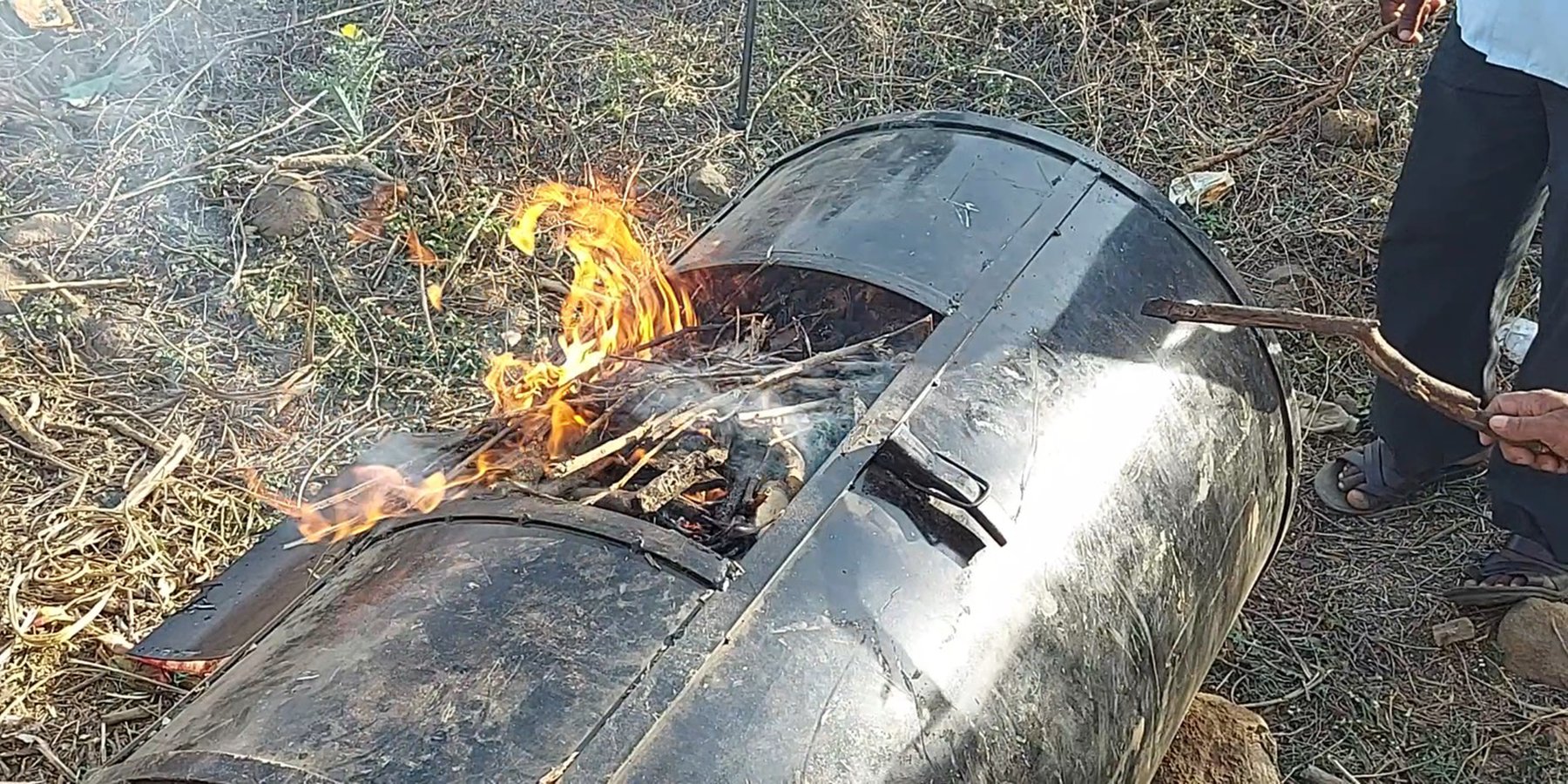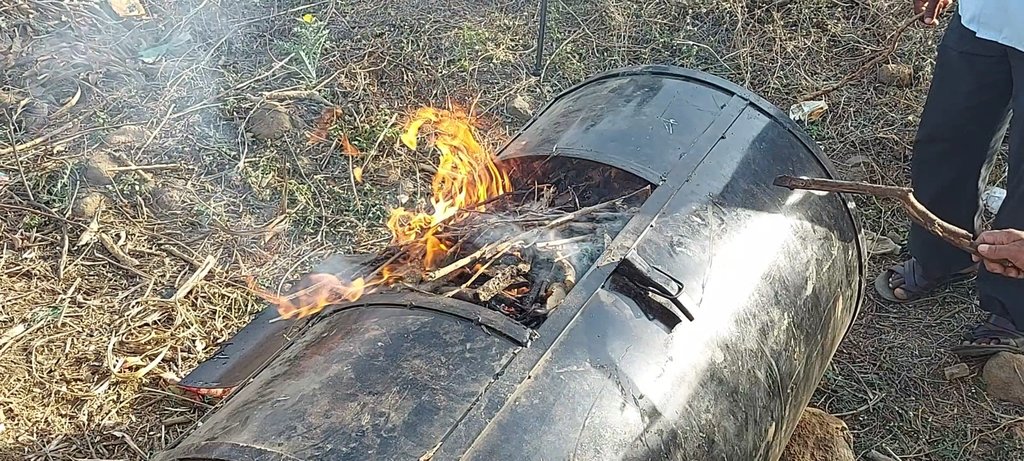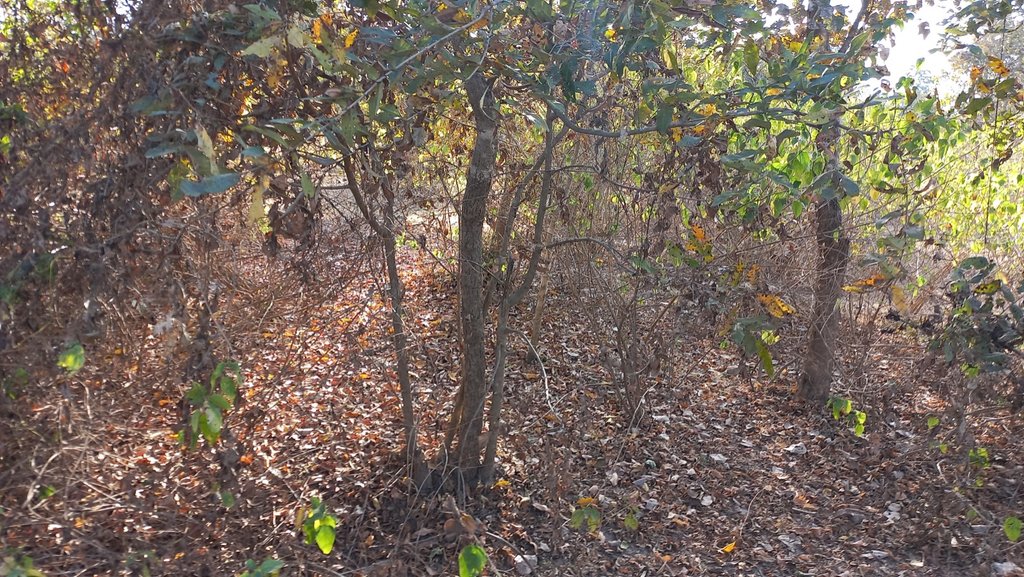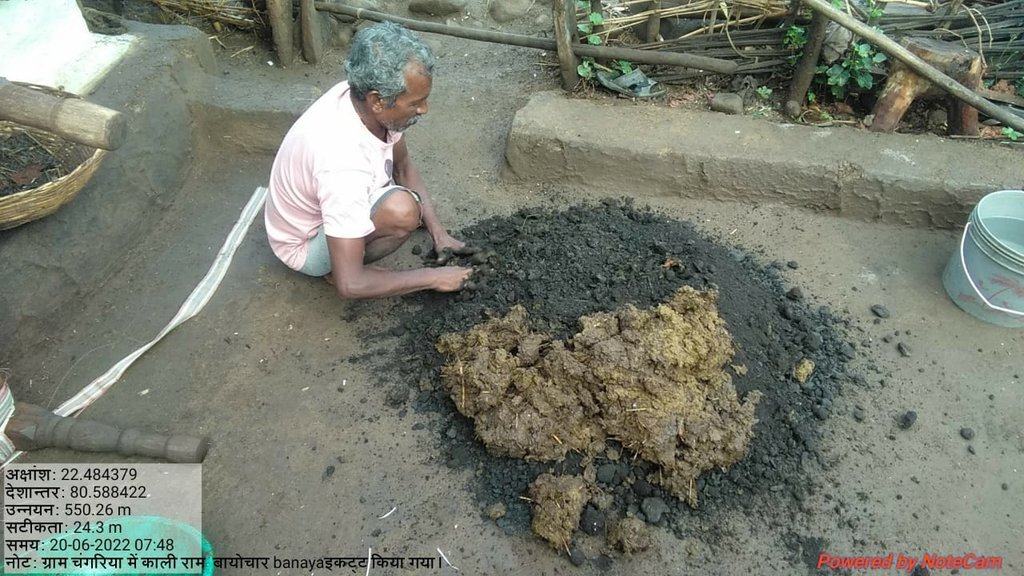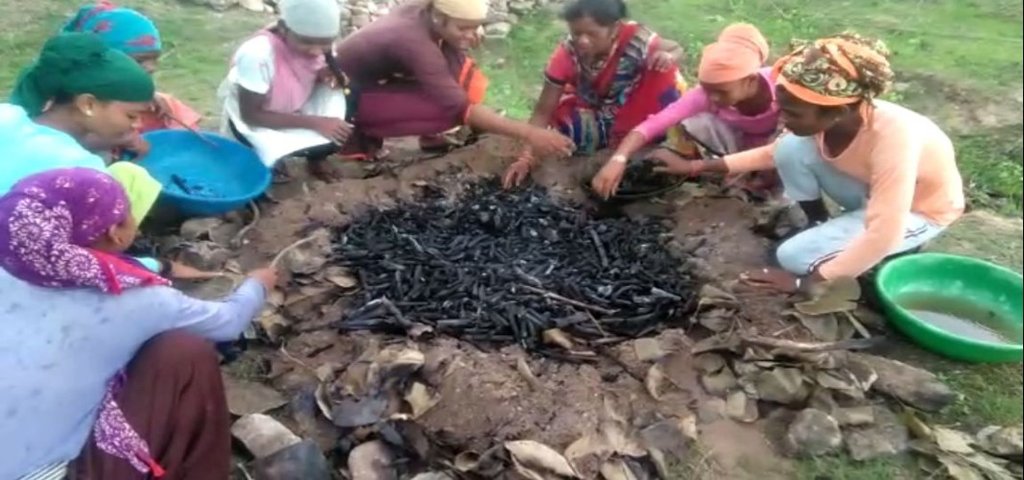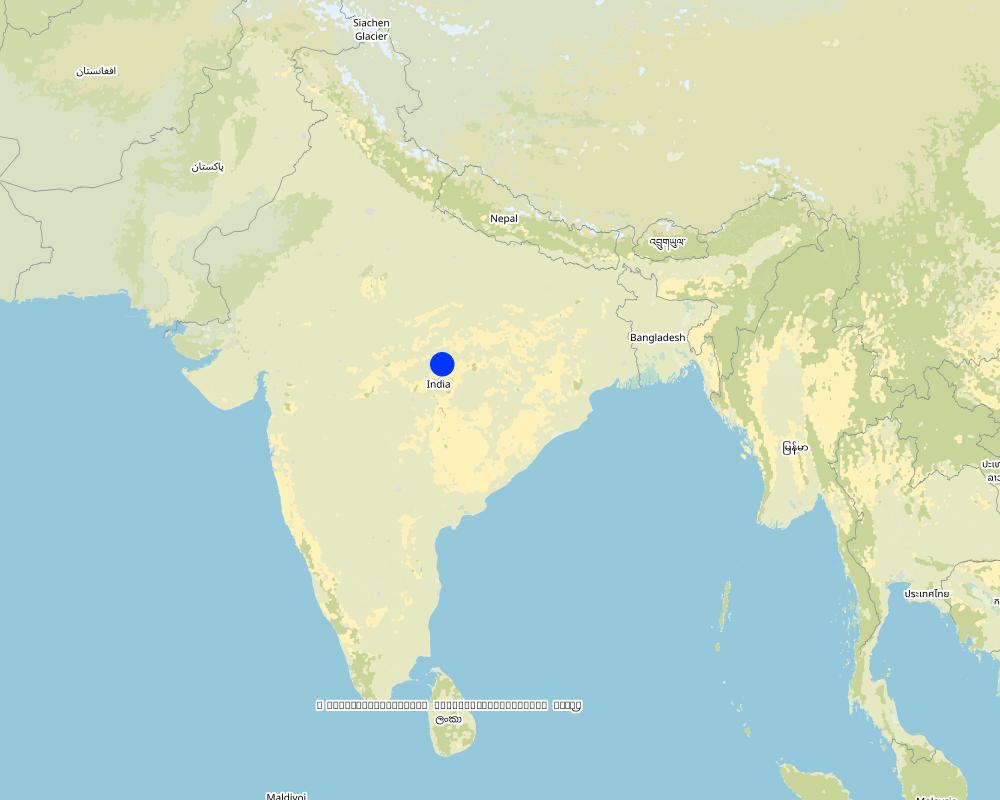Biochar Production from the Invasive Species Lantana Camara [Índia]
- Criação:
- Atualização:
- Compilador/a: Santosh Gupta
- Editores: Noel Templer, Stephanie Katsir, Kim Arora
- Revisor: Udo Höggel
technologies_6690 - Índia
Veja as seções
Expandir tudo Recolher tudo1. Informação geral
1.2 Detalhes do contato das pessoas capacitadas e instituições envolvidas na avaliação e documentação da tecnologia
Nome da(s) instituição(ões) que facilitou(ram) a documentação/ avaliação da Tecnologia (se relevante)
Deutsche Gesellschaft für Internationale Zusammenarbeit (GIZ) GmbH (GIZ) - AlemanhaNome da(s) instituição(ões) que facilitou(ram) a documentação/ avaliação da Tecnologia (se relevante)
Alliance Bioversity and International Center for Tropical Agriculture (Alliance Bioversity-CIAT) - QuêniaNome da(s) instituição(ões) que facilitou(ram) a documentação/ avaliação da Tecnologia (se relevante)
Ecociate Consultants (Ecociate Consultants) - Índia1.3 Condições em relação ao uso da informação documentada através de WOCAT
O/a compilador/a e a(s) pessoa(s) capacitada(s) aceitam as condições relativas ao uso de dados documentados através da WOCAT:
Sim
1.4 Declaração de sustentabilidade da tecnologia descrita
A tecnologia descrita aqui é problemática em relação a degradação da terra de forma que não pode ser declarada uma tecnologia de gestão sustentável de terra?
Não
Comentários:
The technology discusses one of the sustainable land management practices that rehabilitate soil health by eradicating invasive species of Lantana Camara and using it to prepare biochar.
2. Descrição da tecnologia de GST
2.1 Descrição curta da tecnologia
Definição da tecnologia:
Lantana Camara, an invasive species in India, negatively impacts biodiversity and agriculture. Biochar made from its biomass can help manage the species effectively. Traditionally farmers produce biochar in soil pit kilns. Another low-cost portable kiln unit of biochar preparation is a viable option for rainfed areas, designed to work on the direct up-draft principle with bottom ignition and circular vents for uniform heat transfer.
2.2 Descrição detalhada da tecnologia
Descrição:
Lantana Camara was introduced into India as an ornamental plant in 1809 by the British in Calcutta Botanical Garden. Lantana Camara negatively impacts biodiversity and native biota, disrupting the succession cycle, altering the structure and floral composition of native communities, and causing problems in agricultural lands in various regions of India. Its dense thickets outcompete native pastures, block the movement of grazers, and can cause poisoning. Its allelopathic activities also affect the growth of other species in its proximity. One of the measures to manage invasive species is by turning it into biochar.
Biochar is the charred biomass produced by slow pyrolysis in which organic material is heated under controlled temperatures (300-500°C) without oxygen. Lantana Camara is an ideal biomass for biochar production due to its high diversity and wide distribution. In addition to protecting ecosystems, invasive plant-derived biochar has potential applications in environmental remediation and soil amendment due to its unique structure, composition, and adsorption properties.
In the Mandla district of Madhya Pradesh, low-cost technologies for producing biochar are being practised. A low-cost portable kiln unit has been used in the Mandla District to cater to the needs of small and marginal farmers. One unit costs approximately Rs. 7000-12000 depending upon the design and location, including a metal drum, vent-making charges, and side fittings. The kiln is designed to work on the direct up-draft principle with bottom ignition. It is a vertical, single-barrel structure with a perforated base. The kiln has a square-shaped loading hole at the top, which can be closed at the end of conversion with a metal lid with a handle. The kiln has circular vents, a staggered arrangement to avoid rows, and a central vent to hold a wooden pole. Under open atmospheric conditions, the vents at the kiln base hasten hot gas movement through the bio-residues for uniform heat transfer by primary air movement. The kiln's top hole vents the released water vapours and hot gases. A strip of metal is welded around at 3/4th height of the kiln, to which two metal rods are welded on opposite sides to serve as lifting jacks. Dry Lantana Camara feedstock is placed inside the kiln unit, and a fire is lit at the bottom. Through a pyrolysis process, the organic compounds present in the biomass decompose at a specific temperature in an oxygen-limited environment.
Prior to use, the stalks/twigs of lantana are manually cut into appropriate pieces 15-19 cm long and 0.9-1.0 cm in diameter using a commonly used axe in order to achieve better packing density. Dry residues are a prerequisite to hasten satisfactory and quicker conversion. The dried residues of lantana are placed in the unit and are burned from the bottom in an oxygen-limited environment. Generally, the burning process takes 6-8 hours through a slow pyrolysis process. Once complete, the kiln is quenched with soil and left to cool for 3-4 hours. This simple and affordable biochar production method can help manage invasive plant species and benefit agriculture, the environment, and energy. The conversion ratio from biomass to biochar in the case of Lantana is around 20-25%. Farmers have reported of burning around 100 kg of dried Lantana biomass to get ~20 kg of biochar in one operation of the unit. The application rate of biochar varies from crop to crop and the type of soil and other characters. In studied project farmers do apply 20 kg of biochar mixed with 20 kg of cow dung and 20 kg of cow urine in an area of around 1 acre.
The burned biomass of Lantana after the process looks like the coal sticks, these sticks are pulverised through a pulveriser to make a powdered material for application in the field. The biochar is mixed with an equal quantity of cow dung and cow urine before the application. Some farmers also mix the native soils in biochar to get better results.
2.3 Fotos da tecnologia
2.4 Vídeos da tecnologia
Comentários, breve descrição:
YouTube video accessible at https://youtu.be/MPj4_I5BFRE
2.5 País/região/locais onde a tecnologia foi aplicada e que estão cobertos nesta avaliação
País:
Índia
Região/Estado/Província:
Madhya Pradesh
Especificação adicional de localização:
Mandla
Especifique a difusão da tecnologia:
- Aplicado em pontos específicos/concentrado numa pequena área
O(s) local(is) tecnológico(s) está(ão) localizado(s) em uma área permanentemente protegida?
Não
Comentários:
Farmers from the Mandla District of Madhya Pradesh State in India use the cost-effective technology of biochar preparation from Lantana Camara.
Map
×2.6 Data da implementação
Indique o ano de implementação:
2020
2.7 Introdução da tecnologia
Especifique como a tecnologia foi introduzida:
- durante experiências/ pesquisa
- através de projetos/intervenções externas
Comentários (tipos de projeto, etc.):
FES has worked effectively with the community to eradicate Lantana Camera from private and common land and use it for the preparation of biochar
3. Classificação da tecnologia de GST
3.1 Principal/principais finalidade(s) da tecnologia
- Melhora a produção
- Reduz, previne, recupera a degradação do solo
- Preserva ecossistema
- Preservar/melhorar a biodiversidade
- Criar impacto econômico benéfico
3.2 Tipo(s) atualizado(s) de uso da terra onde a tecnologia foi aplicada
Uso do solo misturado dentro da mesma unidade de terra:
Sim
Especificar o uso misto da terra (culturas/ pastoreio/ árvores):
- Agrofloresta

Terra de cultivo
- Cultura anual
Cultivo anual - Especificar culturas:
- cereais - painço
- legumes - outros
- Fallow - maize/sorghum/millet
Número de estações de cultivo por ano:
- 2
O cultivo entre culturas é praticado?
Sim
Em caso afirmativo, especifique quais são as culturas intercultivadas:
Millets, Mustard, Mixed Vegetables, Maize
O rodízio de culturas é praticado?
Sim
Caso afirmativo, especifique:
Maize-Mustard/Wheat

Pastagem
Pastagem extensiva:
- Pastoreio transumante
Pastagem intensiva/produção de forragem:
- Semiestabulação/sem pastagem
Tipo de animal:
- búfalo
- gado - lácteo
- caprinos
É praticado o manejo integrado de culturas e pecuária?
Não

Floresta/bosques
- Florestas/bosques (semi)naturais
Florestas (semi)naturais/ bosques: Especificar o tipo de manejo:
- Retirada de madeira morta/podas
- Uso florestal não madeireiro
As árvores especificadas acima são decíduas ou perenes?
- decíduas mistas/perene
Produtos e serviços:
- Madeira
- Lenha
- Frutas e nozes
- Outros produtos florestais
- Pastagem/Alimentação de folhas e brotos
- Conservação/proteção da natureza
Comentários:
Lantana camara is a highly invasive plant species that can quickly spread and take over private and common land. The plant can spread rapidly by seeds or vegetative propagation, and it can grow in various environments. This makes it difficult to control once it has established itself in an area. Lantana Camara outcompetes native plant species, reduces biodiversity and alters ecosystem processes. Additionally, the plant can be toxic to livestock and wildlife, and its dense growth can increase the wildfire risk.
3.3 O uso do solo mudou devido à implementação da Tecnologia?
O uso do solo mudou devido à implementação da Tecnologia?
- Não (Continuar com a pergunta 3.4)

Outros
Especifique:
Removal of Lantana and making use of its biomass for preparation of biochar
Observações:
In the case of Lantana Camara, making biochar from the plant material can help to prevent the spread of the invasive species while also producing a helpful product. Biochar has many potential uses, including as a soil amendment, a carbon sequestration tool, and a renewable energy source.
3.4 Abastecimento de água
Abastecimento de água para a terra na qual a tecnologia é aplicada:
- Precipitação natural
Comentários:
Approximately 9% of the net area sown has some source of irrigation, rest is rainfed (Source, CGWB, 2013). Significantly used sources of irrigation are canals, dug well, and tanks/ponds.
3.5 Grupo de GST ao qual pertence a tecnologia
- Gestão natural e seminatural de floresta
- Agrofloresta
- Solo/cobertura vegetal melhorada
3.6 Medidas de GST contendo a tecnologia

Medidas agronômicas
- A2: Matéria orgânica/fertilidade do solo

Medidas vegetativas
- V4: Substituição ou retirada de espécies exóticas/invasivas

Medidas de gestão
- M1: Mudança no tipo de uso da terra
- M5: Controle/mudança de composição de espécies
3.7 Principais tipos de degradação da terra abordados pela tecnologia

Deteriorização física do solo
- Ps: Subsidência de solos orgânico, sedimentação do solo
- Pu: perda da função bioprodutiva devido a outras atividades

Degradação biológica
- Bc: redução da cobertura vegetal
- Bh: perda dos habitats
- Bf: efeitos prejudiciais de incêndios
3.8 Redução, prevenção ou recuperação da degradação do solo
Especifique o objetivo da tecnologia em relação a degradação da terra:
- Prevenir degradação do solo
- Reduzir a degradação do solo
Comentários:
The application of biochar improves soil health by improving the soil's organic carbon and enhancing the soil's water-holding capacity
4. Especificações técnicas, implementação de atividades, entradas e custos
4.1 Desenho técnico da tecnologia
Especificações técnicas (relacionada ao desenho técnico):
Drawing of the biochar kiln developed by the expert agency
4.2 Informação geral em relação ao cálculo de entradas e custos
Especifique como custos e entradas foram calculados:
- por área de tecnologia
Outro/moeda nacional (especifique):
INR
Se for relevante, indique a taxa de câmbio do USD para moeda local (por exemplo, 1 USD = 79,9 Real): 1 USD =:
80,0
Indique a média salarial da mão-de-obra contratada por dia:
204
4.3 Atividades de implantação
| Atividade | Periodicidade (estação do ano) | |
|---|---|---|
| 1. | Pyrolysis of Biomass (Lantana camara) in Biochar kiln unit | October-November and June-July (Before the winter and monsoon cropping seasons). |
| 2. | Pulverisation of coal sticks received after the Pyrolysis process | October-November/June-July (Immediately after the Pyrolysis process ) |
Comentários:
The availability of moisture in the soil makes the uprooting/removal of Lantana camara easy, that's the reason behind its removal in the post-monsoon season. Biochar is produced by the farmers just before the cropping seasons. Monsoon (Known as Kharif) and Winter (Known as Rabi) are the most dominant cropping seasons in India.
The establishment cost of a biochar production Kiln is low, as it is specially designed for small and marginal farmers. The unit once purchased can be used for 8-10 years with a very low maintenance cost.
4.4 Custos e entradas necessárias para a implantação
| Especifique a entrada | Unidade | Quantidade | Custos por unidade | Custos totais por entrada | % dos custos arcados pelos usuários da terra | |
|---|---|---|---|---|---|---|
| Equipamento | Biochar Kiln | Number | 1,0 | 7000,0 | 7000,0 | 25,0 |
| Equipamento | Pulverizer unit | Number | 1,0 | 20000,0 | 20000,0 | 25,0 |
| Custos totais para a implantação da tecnologia | 27000,0 | |||||
| Custos totais para o estabelecimento da Tecnologia em USD | 337,5 | |||||
Se o usuário da terra arca com menos que 100% dos custos, indique quem cobre os custos remanescentes:
The remaining cost is being covered by the project funds routed through community organisations
Comentários:
The design of the biochar kiln is simple, there is hardly any cost involved in maintaining the unit. Labour cost is required generally for the removal of Lantana Camara and for the preparation of the biochar. Exact costs cannot be indicated at this time.
4.5 Atividades recorrentes/manutenção
| Atividade | Periodicidade/frequência | |
|---|---|---|
| 1. | Preparation of Biochar | Before the sowing of Rabi and Kharif season (Month of October/November and June/July) |
| 2. | Application of Biochar in the field | During the crops seasons; |
Comentários:
No maintainance cost is involved in preparing biochar from Lantana Camara, as the design of the kiln is straightforward and cost-effective. Preventing the regrowth of Lantana Camara in the areas where it is removed is the only monitoring factor involved at regular intervals.
4.6 Custos e entradas necessárias pata a manutenção/atividades recorrentes (por ano)
| Especifique a entrada | Unidade | Quantidade | Custos por unidade | Custos totais por entrada | % dos custos arcados pelos usuários da terra | |
|---|---|---|---|---|---|---|
| Mão-de-obra | Labor cost for removal of lantana | ha | 1,0 | 5000,0 | 5000,0 | 25,0 |
| Mão-de-obra | Preparation of biochar | Person-day | 2,0 | 200,0 | 400,0 | 100,0 |
| Mão-de-obra | Application of biochar in the field | Person-day | 0,5 | 200,0 | 100,0 | 100,0 |
| Mão-de-obra | Transportation of lantana | Trip | 1,0 | 200,0 | 200,0 | 100,0 |
| Fertilizantes e biocidas | Cow dung | kg | 20,0 | 5,0 | 100,0 | 100,0 |
| Fertilizantes e biocidas | Cow urine | kg | 20,0 | 5,0 | 100,0 | 100,0 |
| Custos totais para a manutenção da tecnologia | 5900,0 | |||||
| Custos totais de manutenção da Tecnologia em USD | 73,75 | |||||
Comentários:
Recurring cost includes removing the lantana and preparing biochar, and cow dung and cow urine must be mixed with biochar before application in the field. In most cases, family members are engaged as labour.
4.7 Fatores mais importantes que afetam os custos
Descreva os fatores mais determinantes que afetam os custos:
Cost of the biochar kiln
5. Ambiente natural e humano
5.1 Clima
Precipitação pluviométrica anual
- <250 mm
- 251-500 mm
- 501-750 mm
- 751-1.000 mm
- 1.001-1.500 mm
- 1.501-2.000 mm
- 2.001-3.000 mm
- 3.001-4.000 mm
- > 4.000 mm
Especifique a média pluviométrica anual em mm (se conhecida):
1427,00
Especificações/comentários sobre a pluviosidade:
Monsoon season is June-September which has the majority of the rainfall
Indique o nome da estação meteorológica de referência considerada:
District at Glance report of Ministry of Water Resources, Central Groundwater Board, North Central Region BHOPAL, 2013
Zona agroclimática
- Subúmido
- Semiárido
The National Bureau of Soil Survey & Land Use Planning (NBSS&LUP) developed twenty agroecological zones based on the growing period as an integrated criterion of adequate rainfall and soil groups. It delineated boundaries adjusted to district boundaries with a minimal number of regions. Mandla District of Madhya Pradesh lies in a Hot subhumid ecoregion with red and black soil. The part of the district also lies in a semi-arid region as these regions don't have irrigation facilities and the length of the growing period lies between 75-179 days.
Precepitation - 1000–1500mm; Potential Evapotranspiration -1300–1500 mm; Lenght of Growing Period-150–180days
5.2 Topografia
Declividade média:
- Plano (0-2%)
- Suave ondulado (3-5%)
- Ondulado (6-10%)
- Moderadamente ondulado (11-15%)
- Forte ondulado (16-30%)
- Montanhoso (31-60%)
- Escarpado (>60%)
Formas de relevo:
- Planalto/planície
- Cumes
- Encosta de serra
- Encosta de morro
- Sopés
- Fundos de vale
Zona de altitude:
- 0-100 m s.n.m.
- 101-500 m s.n.m.
- 501-1.000 m s.n.m.
- 1.001-1.500 m s.n.m.
- 1.501-2.000 m s.n.m.
- 2.001-2.500 m s.n.m.
- 2.501-3.000 m s.n.m.
- 3.001-4.000 m s.n.m.
- > 4.000 m s.n.m.
Indique se a tecnologia é aplicada especificamente em:
- Não relevante
Comentários e outras especificações sobre a topografia:
The project area is hilly and forested (Satpura hill range) and highly undulating with narrow strips of cultivated plains in the valley portion of the river. The plateau is in the northern part, formed by basalt and east-west trending hill in the southern region. The highest elevation is 934 m amsl in the northern part, and the lowest elevation is around 400 m amsl in the northwestern part of the area. Protected forest areas cover a large majority of the site in the district as part of the Kanha National Park.
5.3 Solos
Profundidade do solo em média:
- Muito raso (0-20 cm)
- Raso (21-50 cm)
- Moderadamente profundo (51-80 cm)
- Profundo (81-120 cm)
- Muito profundo (>120 cm)
Textura do solo (solo superficial):
- Grosso/fino (arenoso)
- Médio (limoso, siltoso)
Textura do solo (>20 cm abaixo da superfície):
- Médio (limoso, siltoso)
- Fino/pesado (argila)
Matéria orgânica do solo superficial:
- Baixo (<1%)
Caso disponível anexe a descrição completa do solo ou especifique as informações disponíveis, p. ex. tipo de solo, PH/acidez do solo, nitrogênio, capacidade de troca catiônica, salinidade, etc.
Soil Testing Parameter status (Average) 2017-20 for the project areas is as follows. This data is based on the soil samples tested by the FES in its soil labs from the project villages.
Soil pH:- 5.906548628; EC (electrical conductivity):- 0.122993577; Soil Organic Carbon:- 0.83%; Nitrogen. :- 293.3696598; Phosphorus:- 25.77762582; Potassium (K):- 139.6696636; Sulphur (S):-18.93457993; Zinc (Zn):- 0.955246706; Boron (Bn):- 0.490850376
5.4 Disponibilidade e qualidade de água
Lençol freático:
5-50 m
Disponibilidade de água de superfície:
Médio
Qualidade da água (não tratada):
Água potável precária (tratamento necessário)
A qualidade da água refere-se a:
tanto de águas subterrâneas quanto de superfície
A salinidade da água é um problema?
Não
Ocorre inundação da área?
Não
Comentários e outras especificações sobre a qualidade e a quantidade da água:
The groundwater status is within the safe limits as per the reports by the Government of Madhya Pradesh. People use water from rivers, streams, and traditional small wells for domestic purposes. In the absence of good vegetative cover, the rainwater washes off the fertile topsoil from the farmlands making the land barren and resulting in the siltation of ponds and other water bodies. Further, a heavy infestation of invasive species such as Lantana Camara compounds the degradation.
The studied block Bichhiya is in a better position in terms of stage of groundwater development with 17%, while the average of the district is 7%. The stage of groundwater development refers to the % of groundwater being used for various purposes from the available groundwater in that area e.g. net annual groundwater availability in Bichhiya block is 9087 ham (hectare meters) while the existing annual ground water draft for all usage is 1523 ham, making it a 17% groundwater development stage.
Source: http://cgwb.gov.in/District_Profile/MP/Mandla.pdf
5.5 Biodiversidade
Diversidade de espécies:
- Alto
Diversidade de habitat:
- Alto
Comentários e outras especificações sobre biodiversidade:
The area is surrounded by Kanha National Park and Phen Wildlife Sanctuary, with a good presence of forest area. World famous Kanha Tiger Reserve is situated in the Mandla district. Kanha is famous for Tiger and Barasingha. Kanha has numerous species of insects, butterflies, reptiles, fishes, and other lesser life forms. Important mammals, birds, reptiles, crustaceans, amphibians, insects, mollusks, and fishes are found in Kanha National Park. The faunal diversity of the district represents 32 wild animals, 63 birds, 4 fishes, and 9 reptile species, respectively. Regarding floral diversity, out of 1006 plant species available in the district, 162 are tree species, followed by 71 species of shrubs, 681 species of herbs, 51 species of climbers, 39 species of grasses, and 2 species of parasites. Mandla is richer in herbaceous species than other adjoining districts like Jabalpur and Seoni.
Source:- Documentation of Biodiversity Status in Mandla District of Madhya Pradesh https://mpsbb.mp.gov.in/completedProject/MB.pdf
5.6 Características dos usuários da terra que utilizam a tecnologia
Sedentário ou nômade:
- Sedentário
Orientação de mercado do sistema de produção:
- misto (subsistência/comercial)
Rendimento não agrícola:
- >50% de toda renda
Nível relativo de riqueza:
- Pobre
- Média
Indivíduos ou grupos:
- Indivíduo/unidade familiar
- Grupos/comunidade
Nível de mecanização:
- Trabalho manual
- Tração animal
Gênero:
- Mulheres
- Homens
Idade dos usuários da terra:
- Jovens
- meia-idade
Indique outras características relevantes dos usuários da terra:
The large majority of the user belong to the tribal community, including some households from an ethnic community called Baiga.
https://en.wikipedia.org/wiki/Baiga_tribe
5.7 Área média de terrenos utilizados pelos usuários de terrenos que aplicam a Tecnologia
- < 0,5 ha
- 0,5-1 ha
- 1-2 ha
- 2-5 ha
- 5-15 ha
- 15-50 ha
- 50-100 ha
- 100-500 ha
- 500-1.000 ha
- 1.000-10.000 ha
- > 10.000 ha
É considerado pequena, média ou grande escala (referente ao contexto local)?
- Pequena escala
5.8 Propriedade de terra, direitos de uso da terra e de uso da água
Propriedade da terra:
- Comunitário/rural
- Indivíduo, intitulado
Direitos do uso da terra:
- Indivíduo
Direitos do uso da água:
- Comunitário (organizado)
- Indivíduo
Os direitos de uso da terra são baseados em um sistema jurídico tradicional?
Sim
Especifique:
The concerned authorities have issued landowners the land certificates.
5.9 Acesso a serviços e infraestrutura
Saúde:
- Pobre
- Moderado
- Bom
Educação:
- Pobre
- Moderado
- Bom
Assistência técnica:
- Pobre
- Moderado
- Bom
Emprego (p. ex. não agrícola):
- Pobre
- Moderado
- Bom
Mercados:
- Pobre
- Moderado
- Bom
Energia:
- Pobre
- Moderado
- Bom
Vias e transporte:
- Pobre
- Moderado
- Bom
Água potável e saneamento:
- Pobre
- Moderado
- Bom
Serviços financeiros:
- Pobre
- Moderado
- Bom
6. Impactos e declarações finais
6.1 Impactos no local mostrados pela tecnologia
Impactos socioeconômicos
Produção
Produção agrícola
Comentários/especificar:
Approximately increase of 15-20% across the crops. Where biochar was used, since this has happened in multiple commodities specifying the number for any crop will not do justice.
Qualidade da safra
Comentários/especificar:
Grain size, the strength of biomass and overall taste of the grains. These are the qualitative measures which can not be addressed in numbers.
Gestão de terra
Disponibilidade e qualidade de água
Disponibilidade de água para irrigação
Comentários/especificar:
Biochar maintains soil moisture thus, farmers need to use less quantity of water for irrigation.
Impactos socioculturais
Conhecimento de GST/ degradação da terra
Impactos ecológicos
Biodiversidade: vegetação, animais
Cobertura vegetal
Comentários/especificar:
Lantana Camara negatively impacts biodiversity and native biota. Its dense thickets outcompete native pastures, blocks the movement of grazers, and can cause poisoning. Its eradication helps improving the vegetative cover.
Diversidade vegetal
Comentários/especificar:
As the density of Lantana Camara in the forest increases, allelopathic interactions increase, and hence, species richness declines (Day et al., 2003).
Espécies exóticas invasoras
Comentários/especificar:
The invasive alien species of Lantana Camara are removed from private and common land.
Diversidade animal
Diversidade de habitat
Clima e redução de riscos de desastre
Risco de incêndio
6.2 Impactos externos mostrados pela tecnologia
Disponibilidade de água
6.4 Análise do custo-benefício
Como os benefícios se comparam aos custos de implantação (do ponto de vista dos usuários da terra)?
Retornos a curto prazo:
positivo
Retornos a longo prazo:
muito positivo
Como os benefícios se comparam aos custos recorrentes/de manutenção(do ponto de vista dos usuários da terra)?
Retornos a curto prazo:
levemente positivo
Retornos a longo prazo:
muito positivo
Comentários:
The cost of biochar production is almost negligible for farmers as it is made using local resources, while the benefits are multifold in terms of crop production, quality, and soil health improvement.
6.5 Adoção da tecnologia
- 1-10%
De todos aqueles que adotaram a Tecnologia, quantos o fizeram espontaneamente, ou seja, sem receber nenhum incentivo/ pagamento material?
- 0-10%
Comentários:
A number of farmers adopted the technology without any financial support from the project
6.6 Adaptação
A tecnologia foi recentemente modificada para adaptar-se as condições variáveis?
Sim
Outros (especificar):
Technology
Especifique a adaptação da tecnologia (desenho, material/espécie, etc):
Several farmers adopted biochar production using a traditional method of digging a pit and preparing the biochar.
6.7 Pontos fortes/vantagens/oportunidades da tecnologia
| Pontos fortes/vantagens/oportunidades na visão do usuário da terra |
|---|
| Communities have found biochar as an essential input to meet the nutrient requirement of their soil. They have improved the quality of their farm produce by applying biochar. |
| Preparation of Biochar using Lantana Camara has emerged as an excellent use for the invasive species, which otherwise was not having any use and was growing like fire in the area |
| Improved production of the farm produce |
| Pontos fortes/vantagens/oportunidades na visão do/a compilador/a ou de outra pessoa capacitada |
|---|
| Biochar is an excellent input for improving soil organic carbon. It can lead to healthy soil with an improved capacity of the soil to sequester carbon. |
| Over the years, soils have degraded to a great extent in the project geography. Biochar can reverse this process. |
| Farmers can grow short-duration crops and fodder for their animals in a rainfed area, with improved soil moisture. This will help improve farmers' income. |
6.8 Pontos fracos, desvantagens/riscos da tecnologia e formas de superá-los
| Pontos fracos/desvantagens/riscos na visão do usuário da terra | Como eles podem ser superados? |
|---|---|
| The capacity of existing biochar kiln units is limited, and farmers have to wait for their turn | More units can be mobilized with community-based engagement and support from externally funded projects |
| Hard work and a long process involved uprooting lantana, drying, transportation, burning, and application | Communities need handholding and training about its importance and more technological advances |
| Pontos fracos/vantagens/riscos na visão do/a compilador/a ou de outra pessoa capacitada | Como eles podem ser superados? |
|---|---|
| In the long run, the easy accessibility of Lantana may be a concern if it is implemented on a large scale. The availability of other biomass is very much limited. | An assessment of the availability of Lantana and its annual requirement for biochar preparation can be done |
| Biochar has long-term benefits, while communities look for short-term solutions | Handholding the communities along with linking them with carbon credit-related projects may be a good option to keep farmers motivated |
| Regular application of biochar over the years | Regular communication with farmers about the positive outcome aligned with other financial incentives linked to soil organic carbon improvement |
7. Referências e links
7.1 Métodos/fontes de informação
- visitas de campo, pesquisas de campo
1
- entrevistas com usuários de terras
10
- compilação de relatórios e outra documentação existente
3
Quando os dados foram compilados (no campo)?
22/02/2023
Comentários:
During the field visit, detailed discussions were held with the project implementing agency, communities, and other stakeholders to understand the process and impact of the intervention.
7.2 Referências às publicações disponíveis
Título, autor, ano, ISBN:
Invasive plants as potential sustainable feedstocks for biochar production and multiple applications: A review, Qianwei Feng a, Bing Wang a b c, Miao Chen a b c, Pan Wu a b c, Xinqing Lee d, Ying Xing e
Disponível de onde? Custos?
https://doi.org/10.1016/j.resconrec.2020.105204
Título, autor, ano, ISBN:
Biochar for Soil Health Enhancement and Crop Productivity Improvement, Awtar Singh1*, A.P. Singh2, V. Singh1, Arijit Barman1, Sagar Vibhute1 and R.S. Tolia
Disponível de onde? Custos?
Innovative Farming, 1(4): 137-140, 2016
Título, autor, ano, ISBN:
A review of Lantana camara studies in India, Neena Priyanka*,**, P. K. Joshi*
Disponível de onde? Custos?
International Journal of Scientific and Research Publications, Volume 3, Issue 10, October 2013 ISSN 2250-3153
Título, autor, ano, ISBN:
Annual Progress Report on Promotion of Biochar in Mandla, developed by FES for the year 2021-22
Disponível de onde? Custos?
Internal document of FES, shared as part of the project report to GIZ. This document can be obtained from the GIZ office, India
7.3 Links para informações on-line relevantes
Título/ descrição:
District at a glance by Central Ground Water Board
URL:
http://cgwb.gov.in/District_Profile/MP/Mandla.pdf
Título/ descrição:
Low cost Kiln for Biochar Production
URL:
http://www.nicra-icar.in/nicrarevised/images/Home/NICRA%20Technical%20Brochure%20Portable%20Kiln.pdf
Título/ descrição:
Baiga Tribes
URL:
https://en.wikipedia.org/wiki/Baiga_tribe
Título/ descrição:
Biochar on soil properties and crop performance
URL:
https://www.indiascienceandtechnology.gov.in/research/biochar-soil-properties-and-crop-performance
Título/ descrição:
Video by FES on Biochar production (Hindi)
URL:
https://www.youtube.com/watch?v=MPj4_I5BFRE
Título/ descrição:
A review of Lantana camara studies in India
URL:
https://www.ijsrp.org/research-paper-1013/ijsrp-p2207.pdf
Título/ descrição:
Low Cost Portable Kiln for Biochar Production
URL:
http://www.nicra-icar.in/nicrarevised/images/Home/NICRA%20Technical%20Brochure%20Portable%20Kiln.pdf
Links e módulos
Expandir tudo Recolher tudoLinks
Não há links
Módulos
Não há módulos


